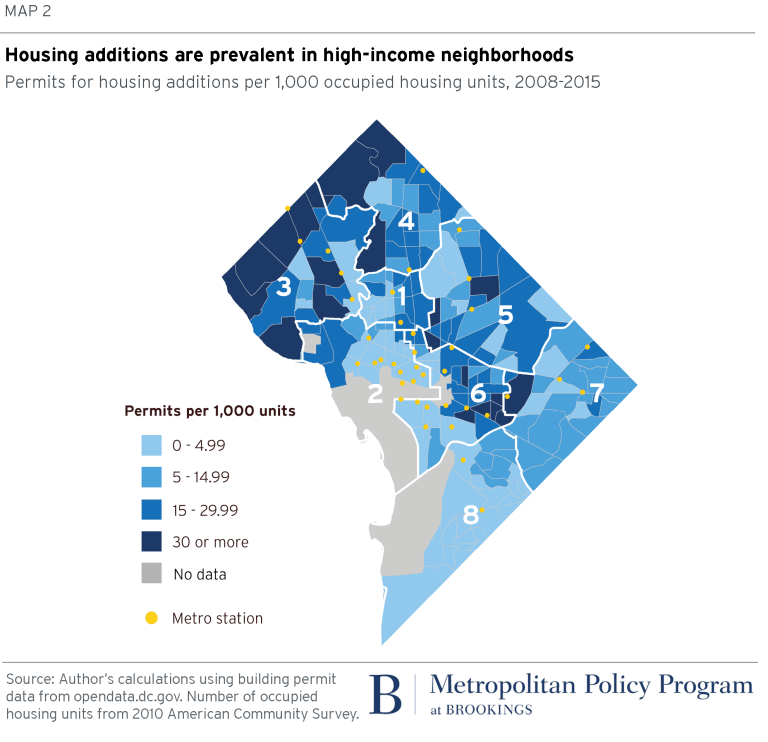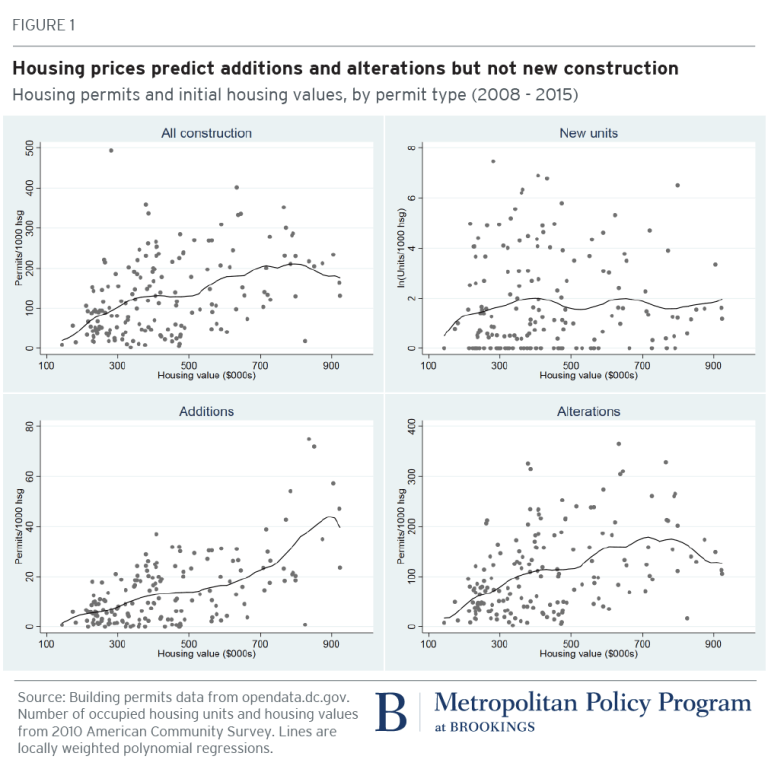White, wealthy areas of DC aren’t building their fair share of homes
_800_600_90.jpg)
Rowhouses on Capitol Hill by Erin used with permission.
Where has DC built new homes? Jenny Schuetz wrote an analysis for The Brookings Institution showing that most new housing and development is concentrated in lower- and moderate-income areas in Wards 5 and 6 like NoMa, Southwest Waterfront, Shaw, and Brookland. Meanwhile, the District's wealthy, white neighborhoods have built almost no new homes.
Why's that? “The District’s current zoning and politics insulate the city’s wealthy areas from change, while lower-income families struggle to afford ever-increasing rents,” Schuetz writes.
The author notes that many of these fastest-growing neighborhoods tend to fringe older, more expensive, and “more desirable” housing locations such as Capitol Hill and U Street. Some of them — like NoMa, Union Market, and Brookland — are formerly industrial sites that used to serve these neighborhoods and have since been up-zoned.
Wealthy, white areas aren’t building their share of homes
Approximately one third of the Census tracts in DC recieved almost zero permits to build housing from 2008 to 2015. The areas that built few or no new homes are largely white, wealthy areas concentrated mostly in Northwest, such as Chevy Chase, Friendship Heights, and the Palisades.
Calculations by Jenny Schuetz. Image used with permission.
A key reason for wealthy neighborhoods not building housing has to do with restrictive land use regulations and zoning codes. As Schuetz puts it, “Wealthy neighborhoods aren’t building their “fair share” of new housing – at any price level.”
Wealthy residents have more leverage to resist development in order to protect their home values, often under the guise of “stability” and “neighborhood character.”
Housing additions are a different story, however. Residents in high-income, high-value neighborhoods are investing in pop-ups, bump-outs, and the like. It's likely that affluent residents have more money to spend on sprucing up their homes.
Calculations by Jenny Schuetz. Image used with permission.
Alterations, like redoing a bathroom or deck, were more evenly distributed across the city and were by far the most common permit issued. Nonetheless, there are still more of them issued to owners of older and higher-priced housing, and in areas where there are higher rates of ownership in Wards 1, 3, 4, and 6.
Calculations by Jenny Schuetz. Image used with permission.
Schuetz finds that median home values in DC increased by 5% annually. In 10 years, that’s at least a 50% increase in home values, and some experienced even larger gains. Unfortunately, she shows that these gains have disproportionately gone towards whiter and wealthier groups.
While it can make economic sense for developers to build in less expensive sites such as industrial areas, we also see these patterns because of how the city is zoned. Most of the wealthy areas in Northwest DC are zoned as single-family or lower-density housing, compared to higher-density housing zones in other parts of the city.
Why are we seeing this crunch?
Many large metropolitan areas such as the San Francisco Bay Area, New York, Boston, and Houston have been experiencing a housing supply crunch in the last decade. A significant portion of this crunch comes from land-use restrictions, or zoning.
There is emerging evidence that these restrictions are hampering economic growth and output. This housing crunch and its economic impact is evident in DC where a booming economy has resulted in a population that has grown twice as fast as its housing supply from 2010 to 2016, according to Census Bureau data.
Chang-Tai Hsieh and Enrico Moretti write in the New York Times, “…Without these regulations, our research shows, the United States economy today would be 9% bigger — which would mean, for the average American worker, an additional $6,775 in annual income.”
Part of the issue is that workers are not being paid a livable wage. “Only in 22 counties in the United States is a one-bedroom home affordable to someone working 40 hours per week at federal minimum wage,” Tanvi Misra writes in CityLab. Even Puerto Rico, on average, is unaffordable at the federal minimum wage of $7.25.
People flock to cities with job opportunities, which leads to large increases in housing prices. This creates a feedback loop of increasing demand and increasing supply of jobs — but meanwhile, the overall housing supply remains low and wages remain stagnant for many workers, leading to displacement when original residents can no longer afford to live in the city.
Where DC puts new homes is a question of equity
Scheutz also looked into what kinds of housing is being built. She found about 70% of new housing is large multifamily apartment or condo buildings, as opposed to smaller single-family homes. That means that a significant portion of DC’s newer housing stock are developments of 50 units or more, which fall under inclusionary zoning and affordable housing requirements.
To recoup costs and create profits, developers often put in “luxury” buildings. When developers are unable to build in wealthy neighborhoods, they end up placing them in lower-income ones, sometimes displacing the original residents there.
Some groups in DC have opposed these large developments with mass lawsuits, but unfortunately, decreasing the size of a development often results in a loss of affordable housing as well. Developments over a certain size are required to designate some units as affordable, and developers often add more such units in exchange for allowing a taller building than the zoning code allows.
Speaking generally, any significant increase in the housing supply correlates with either a plateau or a drop in housing prices, as Los Angeles has shown. While increasing housing supply alone will not solve affordability, it can play a significant role in a larger solution.
Matthew Yglesias and others have argued that wealthy communities who can best bear the impacts of development should be upzoned and build more homes for new residents, instead of poorer communities absorbing the vast majority of the growth.
Fundamentally, Scheutz's study shows we're not being equitable in developing new housing units. She also hints at a way forward: build more housing in neighborhoods, such as Chevy Chase and Dupont Circle, that have the ability to absorb new neighbors.
